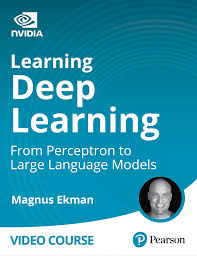
Mastering Deep Learning with Magnus Ekman: A Comprehensive Guide
Learning Deep Learning with Magnus Ekman
Deep learning has become a cornerstone of modern artificial intelligence, powering advancements in areas ranging from natural language processing to computer vision. As the field continues to evolve, the need for comprehensive resources to understand and implement deep learning models is more crucial than ever. One such invaluable resource is the work of Magnus Ekman, whose contributions have significantly impacted how deep learning is taught and understood.
About Magnus Ekman
Magnus Ekman is a renowned expert in the field of deep learning, known for his ability to distill complex concepts into accessible and practical knowledge. With a rich background in computer science and extensive experience in AI research and development, Ekman has dedicated much of his career to educating others about the intricacies of deep learning.
The Book: “Learning Deep Learning”
One of Magnus Ekman’s most notable contributions is his book titled “Learning Deep Learning“. This comprehensive guide serves as both an introduction for beginners and a detailed reference for seasoned practitioners. The book covers fundamental concepts such as neural networks, backpropagation, and optimisation techniques while also delving into advanced topics like convolutional networks and recurrent neural networks.
Key Features:
- Hands-On Approach: The book emphasises practical implementation with numerous examples and exercises that encourage readers to apply what they have learned.
- Theoretical Insights: While focusing on application, it also provides deep theoretical insights that help readers understand the underlying principles of deep learning algorithms.
- Cutting-Edge Topics: It explores recent advancements in the field, ensuring that readers are up-to-date with current trends and technologies.
The Impact on Learners
Learners who engage with Magnus Ekman’s teachings gain not only technical skills but also a deeper appreciation for the potential of AI technologies. His structured approach helps demystify complex topics, making them accessible to a wider audience. Whether you’re an aspiring data scientist or an experienced engineer looking to enhance your skill set, “Learning Deep Learning” provides valuable insights that can propel your understanding forward.
Conclusion
Magnus Ekman’s contributions to the field of deep learning education are invaluable. Through his work, he has empowered countless individuals to explore the vast potential of AI technologies. As interest in artificial intelligence continues to grow, resources like “Learning Deep Learning” will remain essential for anyone looking to deepen their understanding and harness the power of this transformative technology.
Frequently Asked Questions about Deep Learning: Steps, Learning Path, ChatGPT, and Key Concepts
- Which are the three steps of deep learning?
- How to learn deep learning step by step?
- Is chat GPT based on deep learning?
- What is the concept of deep learning?
Which are the three steps of deep learning?
When exploring the realm of deep learning, a frequently asked question revolves around the fundamental steps that underpin this complex field. Magnus Ekman, a prominent figure in deep learning education, often emphasises the three key steps of deep learning: data preprocessing, model building, and model evaluation. These steps form the foundational framework for developing effective deep learning models. Data preprocessing involves cleaning and preparing the data to ensure its quality and relevance for training. Model building entails designing and training neural networks to learn patterns from the data. Finally, model evaluation assesses the performance of the trained model to determine its effectiveness in making accurate predictions. Understanding and mastering these three steps are essential for anyone looking to delve into the world of deep learning with Magnus Ekman’s guidance.
How to learn deep learning step by step?
When it comes to learning deep learning step by step, Magnus Ekman’s expertise and educational resources offer invaluable guidance. Beginners embarking on their deep learning journey can benefit from a structured approach that Magnus Ekman advocates in his teachings. Starting with foundational concepts such as neural networks and gradually progressing towards more advanced topics like convolutional networks and recurrent neural networks, learners can follow a clear path to deepen their understanding of deep learning. By combining theoretical insights with hands-on practice through exercises and examples, Magnus Ekman’s approach ensures that individuals can grasp the intricacies of deep learning in a systematic and effective manner.
Is chat GPT based on deep learning?
The frequently asked question about whether ChatGPT is based on deep learning is a common inquiry among those exploring the realm of artificial intelligence. In response, it is important to note that ChatGPT, like many other advanced natural language processing models, is indeed built on deep learning principles. Leveraging deep neural networks, ChatGPT processes and generates text by learning patterns and structures from vast amounts of data. This foundation in deep learning enables ChatGPT to understand and generate human-like responses in conversations, showcasing the power and versatility of deep learning techniques in the development of AI-driven chatbots and language models.
What is the concept of deep learning?
Deep learning is a subset of machine learning that focuses on algorithms inspired by the structure and function of the brain, known as artificial neural networks. This concept involves training these networks to recognise patterns and make decisions by processing vast amounts of data through multiple layers. Each layer in a deep learning model extracts increasingly complex features from the input data, allowing the system to learn representations at various levels of abstraction. This hierarchical approach enables deep learning models to excel in tasks such as image recognition, natural language processing, and speech recognition, where traditional algorithms might struggle. Magnus Ekman’s work on deep learning provides a comprehensive understanding of these concepts, making it accessible for learners to grasp how these sophisticated models are developed and applied in real-world scenarios.
